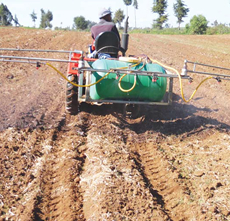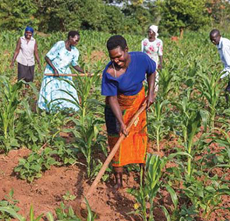Weed Management: Practices For Integrated Solutions
 Integrated Weed Management (IWM) is a comprehensive method to control and mitigate infestation in fields incorporating diverse techniques. The oldest way to tackle the problem is manual pulling. Yet, it is labor and time consuming due to vast areas and short staff.
Integrated Weed Management (IWM) is a comprehensive method to control and mitigate infestation in fields incorporating diverse techniques. The oldest way to tackle the problem is manual pulling. Yet, it is labor and time consuming due to vast areas and short staff.
Nowadays, most farmers rely on herbicides. However, sustainable agriculture and organic farming require a profound reconsideration of the approach as chemical residues harm both humans and nature, and many herbs develop resistance to chemical substances. In this regard, alternative and integral weed management plans are the most beneficial option with a thought of the future.
Methods Of Weed Control
Weed management in agricultural fields includes quite many events and tactics that make five main groups. They are as follows.
(1) Preventative Weed Control
This management method aims to avoid contamination of the planting material and cultivated areas. It involves:
- buying high-quality weed-free seeds
- washing equipment
- checking livestock’s fur and legs
- screening irrigation waters for weed seed transportation
- use of thoroughly rotten compost and manure to prevent seed germination.
(2) Cultural Weed Control
It ensures field conditions that are less favorable for non-crops to develop. The given management approach includes:
- planting high-adaptive and competitive species
- selecting big seeds that are likely to produce strong and vibrant plants
- crop rotation
- field fallowing
- use of cover crops
- reduction of space between rows
- shallow seeding (thus, crops can grow faster than other herbs)
- planting local species that adapt to the natural environment and compete with weeds easier.
3) Mechanical Weed Control
This management technique suggests destroying unwanted plants with farming equipment or manually. This aspect of management utilizes:
- ploughing
- tilling
- mowing
- manual pulling (hand removal)
- burning
- mulching
- covering space between rows (for example, with straw)
- robotic weeding machines
- weed seed destructors
- haymaking before weeds burst with seeds.
(4) Biological Weed Control
It employs plant enemies in their habitats. Thus, sheep, tansy flea beetles, and cinnabar moths destroy tansy ragwort. Grazing is another example of the management technique.
Biological control also includes placing pathogen organisms like bacteria, fungi that attack certain species. They are diverse and damage separate parts (leaves, stems, seeds, roots).
Biological weed management was successfully undertaken in north-east Australia in the early 20th century when the cactoblastis moth battled the prickly pear with other cases to follow.
The timely release of biological agents helps farmers to tackle the issue in a simple and eco-friendly manner as it happens in the natural environment.
However, imposing this management method on areas that are not natural habitats for foreign plants is highly questionable, needs thorough research, and should be applied with care. If populations of biological enemies develop faster than species they destroy, the situation turns into an ecological disaster bringing more harm than benefit. They become pests themselves. Furthermore, biological agents even threaten non-target plant species at times.
(5) Chemical Weed Control
The practice implies an application of industrial chemical products to defeat infestation. Even though this approach gives quick results, it is poisonous and causes harm to organisms and natural resources. Another aspect is resistance and ineffectiveness of herbicides as a consequence. Besides, chemical applications involve cost inputs, especially if used repeatedly. Therefore, it is essential to use herbicides with various modes of action and different mixes. Following label instructions is vital. A significant constituent of chemical control is the correctly scheduled usage of not only herbicides but fertilizers as well. They are beneficial if applied in the optimal period of plant development.
 (Weed Identificationas a Part of Weed Management Plan
(Weed Identificationas a Part of Weed Management Plan
Satellite imagery helps to detect herbal intrusion on various stages of yield production in the fields. It is possible with vegetation indices that allow farmers to notice the problem early and react timely. When satellite charts show weed presence, the next steps are scouting and elaborating balanced weed management solutions.
However, not only fields proper require inspections. Unwanted seeds penetrate with wind and water from fencerows, irrigation ditches, and non-crop terrains, so these zones must be checked and treated as well.
Before Seeding Period
Prior to sowing, one can trace weeds after plowing, depending on if the soil is bare or covered (recently plowed fields are supposed to have no vegetation).
When there are no crops seeded yet, but vegetation is detected, it means these plants are non-crops. The conclusion enables agrarians to make correct management decisions.
Early Season
To detect weeds at the beginning stages of plant growth is rather hard because they are small, and the soil reflectance dominates.
Yet, it is not impossible. When vegetation indices signal about discrepancies in development (either insufficient or excessive), the cause of the anomaly may be weed infestation. Typically, weeds are stronger than crops and develop faster, taking nutrients off the soil and hiding crops from the sunlight.
Crop Monitoring can help to monitor this phenomenon on MSAVI charts that are important for weed management solutions.
Late Season
When crops mature, weed identification becomes simpler. Remote sensing can distinguish drying and withering crops that lose chlorophyll (and thus green coloring) from weeds that are still green. Fading plants acquire yellow and brownish hues. Weed Scouting in Weed Control
Management
When vegetation indices report on critical areas suggesting weed presence, scouting should augment monitoring to confirm infestation or find out another actual issue of deviance in plant growth.
Field scouting can be carried out either by driving to the field, with drones, or with specific scouting apps in agricultural software.
Managing the Chemical Weed Control Effectively
Herbicides are never 100% safe for humans, crops, and soils. Therefore, their applications should be wise and sparing. Major factors enhancing or reducing herbicide efficiency include:
- growth stages
- climatic peculiarities of the area
- weed resistance
- application volumes and density
- retention on leaves
- breakdown by light
- soil content and composition
- methods of application
- rainfalls
- relative air humidity
- air temperature.
Herbicide types and conditions of their usages are critical in agricultural management.
Thus, chemicals lose efficacy when absorbed poorly or washed off from the target plants and areas. Some herbicides are activated only in dry weather when they remain on the soil or plants for a determined period of time. Other herbicide types gain efficiency only after rainfalls or irrigation. Besides, herbicides can burn crops and destroy yields if used in hot weather. Inaccurate time causes repeated applications as a consequence.
Apps with weather precipitation are helpful in this regard, as forecasts are essential to avoid washing chemicals due to rainfalls or their applications on the wrong territories because of winds. Even though herbicides seem to be the fastest (and the most widely used) solution, repeated or incorrect usage reduces their efficiency.
The Crop Monitoring app gives
comprehensive weather precipitation data facilitating management activities. It helps to monitor air temperature, relative humidity, wind speed, and direction. The application also alerts on upcoming rainfalls, equipping farmers with precious knowledge on how to schedule weed control events.
Another important feature of Crop
Monitoring is field zoning. Different zones with different vegetation density require different management. Correspondingly, herbicide volumes should vary depending on the concentration of weeds. By mastering the situation, agrarians can avoid wastes of chemicals and eliminate their harm to crops and natural resources.
When Used In Complex: Integrated Weed Management (IWM)
The advantage of IWM is that it combines different methods of weed control used in agriculture, making the best of the situation. The approach helps to find the most effective and environment-friendly options and avoid unjustified chemical usage. Apart from the harm herbicides cause to nature, crops, and humans, weeds tend to develop resistance to them. Thus, even repeated usage of poisonous substances becomes a waste and danger.
It is essential for sustainable agriculture and is possible with the following management techniques utilized in turns:
- Taking preventive actions
- Crop rotation (different species, especially with various seasons of growth)
- Fallowing
- Weed identification and scouting
- Checking weather forecasts
- Cover crops
- Grazing
- Timely and wise chemical applications
- Correct nutrient distribution.
The integration of these techniques reduces cost inputs and boosts yields. When used in complex, different tactics enhance each other’s benefits and decrease negative impacts. For example, crop rotation helps to remove certain weeds from terrains if they do not co-exist with a new culture species. The presence of natural enemies restrains weed growth. Grazing livestock destroys unwanted plants in pre-seeding or post-harvesting periods. The cleaning of equipment hinders seed spreading.
Cover crops and quality weed-free seeds decrease the necessity of herbicide applications, too. These cases illustrate how cultural, biological, preventative, and chemical types of control work together. Combinations of various tactics and elaboration of weed management plans prove to be the most advantageous approach. They should be cost-effective, efficient (with the least adaptation), and considering the impact on humans and nature.
A good weed control plan for agricultural purposes does not spoil the quality of soil and crops. It includes not only the specific herb to tackle but time and methods to manage the infestation.
Thus, integrated weed management is the most beneficial option in the long-term perspective. It helps achieve economic and ecological goals with the least efforts and harms offering a solution even in the case when some techniques are not suitable.